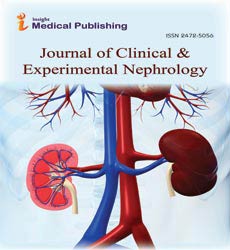Diabetic Nephropathy: A Leading Cause of End-Stage Renal Disease
Carlos Dinis*
Department of Internal Medicine, University of Santo António, Porto, Portugal
Published Date: 2024-10-28DOI10.36648/2472-5056.9.5.280
Carlos Dinis*
Department of Internal Medicine, University of Santo António, Porto, Portugal
- *Corresponding Author:
- Carlos Dinis
Department of Internal Medicine, University of Santo António, Porto,
Portugal,
E-mail: dinicarlos@san.pt
Received date: September 26, 2024, Manuscript No. IPJCEN-24-19845; Editor assigned date: September 30, 2024, PreQC No. IPJCEN-24-19845 (PQ); Reviewed date: October 14, 2024, QC No. IPJCEN-24-19845; Revised date: October 21, 2024, Manuscript No. IPJCEN-24-19845 (R); Published date: October 28, 2024, DOI: 10.36648/2472-5056.9.5.280
Citation: Dinis C (2024) Diabetic Nephropathy: A Leading Cause of End-Stage Renal Disease. J Clin Exp Nephrol Vol.9 No.5: 280.
Description
Diabetic Nephropathy (DN) is one of the most common and severe complications of diabetes, significantly contributing to morbidity and mortality in patients with both type 1 and type 2 diabetes. It is the leading cause of Chronic Kidney Disease (CKD) and End-Stage Renal Disease (ESRD) globally. Diabetic nephropathy is characterized by progressive damage to the kidney's filtering units, known as nephrons, due to long-standing hyperglycemia. Early diagnosis and effective management can slow its progression and reduce the risk of cardiovascular events. This article provides an in-depth understanding of diabetic nephropathy, its pathophysiology, clinical features, diagnosis and available treatment options. Diabetic nephropathy develops through a combination of metabolic and hemodynamic changes induced by chronic hyperglycemia. Persistent high blood glucose levels lead to the accumulation of Advanced Glycation Endproducts (AGEs), which cause oxidative stress and inflammatory responses in the kidneys. These factors contribute to thickening of the glomerular basement membrane, mesangial matrix expansion and podocyte injury, ultimately leading to glomerulosclerosis. Additionally, systemic hypertension, which is commonly present in diabetic patients, worsens the condition by increasing the pressure within the glomeruli. This heightened pressure leads to hyperfiltration and further damage to the nephrons. Over time, these structural changes impair the kidney's ability to filter blood effectively, allowing proteins such as albumin to leak into the urine a condition known as proteinuria.
Diabetic nephropathy
Diabetic nephropathy typically progresses through several stages: In the early stage, the kidneys may enlarge and show signs of hyperfiltration, where the Glomerular Filtration Rate (GFR) is elevated. The first clinical sign of kidney damage in diabetic nephropathy is the presence of microalbuminuria, defined as 30-300 mg/day of albumin in the urine. Patients often remain asymptomatic at this stage. As the disease progresses, albumin excretion exceeds 300 mg/day, leading to overt proteinuria (macroalbuminuria). This is typically accompanied by declining GFR and the onset of hypertension. As glomerular damage worsens, GFR progressively declines, eventually leading to CKD and, without intervention, ESRD. The diagnosis of diabetic nephropathy involves a combination of clinical, laboratory and imaging findings. Key diagnostic markers include: The presence of albumin in the urine is a hallmark of diabetic nephropathy. A Urine Albumin-to-Creatinine Ratio (UACR) is often used to quantify albumin excretion. A drop in GFR is indicative of worsening kidney function. Measuring serum creatinine and estimating GFR (eGFR) helps assess the severity of renal impairment. In certain cases, where the diagnosis is unclear a kidney biopsy may be performed to confirm diabetic nephropathy and rule out other causes of kidney disease.
Dyslipidemia
The management of diabetic nephropathy focuses on slowing the progression of kidney damage and preventing complications. Maintaining blood sugar levels within target ranges is vital in preventing further kidney damage. Medications such as insulin or oral hypoglycemic agents are commonly used to achieve optimal glucose control. Aggressive control of hypertension is essential. Angiotensin-Converting Enzyme Inhibitors (ACEIs) and angiotensin II Receptor Blockers (ARBs) are preferred as they not only lower blood pressure but also reduce proteinuria and slow kidney function decline. Beyond blood pressure control, RAAS inhibition plays a direct role in protecting the kidneys from further damage by reducing intraglomerular pressure. Dyslipidemia is common in diabetic patients and contributes to the progression of nephropathy. Statins are frequently prescribed to manage cholesterol levels and reduce cardiovascular risk. A low-protein diet has been shown to slow the decline in GFR in patients with diabetic nephropathy. Reducing sodium intake is also recommended to manage hypertension and fluid retention. Smoking exacerbates kidney damage and increases the risk of cardiovascular complications in diabetic patients. Smoking cessation is a vital component of disease management. In advanced stages of diabetic nephropathy, when ESRD occurs, Renal Replacement Therapy (RRT) becomes necessary. This includes options such as hemodialysis, peritoneal dialysis, or kidney transplantation. The prognosis of diabetic nephropathy depends on early diagnosis and the effectiveness of interventions. Without adequate control of blood sugar and blood pressure, the disease progresses to ESRD, requiring dialysis or transplantation. However, with timely and effective management, many patients can slow the progression of the disease, maintain kidney function and prevent cardiovascular complications.
Open Access Journals
- Aquaculture & Veterinary Science
- Chemistry & Chemical Sciences
- Clinical Sciences
- Engineering
- General Science
- Genetics & Molecular Biology
- Health Care & Nursing
- Immunology & Microbiology
- Materials Science
- Mathematics & Physics
- Medical Sciences
- Neurology & Psychiatry
- Oncology & Cancer Science
- Pharmaceutical Sciences
